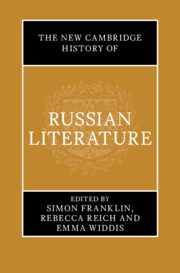Book contents
- The New Cambridge History of Russian Literature
- The New Cambridge History of Russian Literature
- Copyright page
- Contents
- Figures
- Contributors
- Acknowledgements
- On Transliteration, Names, and Dates
- Introduction
- History 1 Movements
- 1.1 The Age of Devotion
- 1.2 The Baroque Age
- 1.3 The Age of Classicism
- 1.4 Sentimentalism and Romanticism
- 1.5 The Natural School and Realism
- 1.6 Symbolism and the Fin de Siècle
- 1.7 Modernism and the Avant-Garde
- 1.8 Socialist Realism
- 1.9 Postmodernism
- 1.10 Contemporary Movements
- Boxes 1 Close Readings
- Boxes 2 Genres
- History 2 Mechanisms
- History 3 Forms
- History 4 Heroes
- Index
- References
1.1 - The Age of Devotion
from History 1 - Movements
Published online by Cambridge University Press: 31 December 2024
- The New Cambridge History of Russian Literature
- The New Cambridge History of Russian Literature
- Copyright page
- Contents
- Figures
- Contributors
- Acknowledgements
- On Transliteration, Names, and Dates
- Introduction
- History 1 Movements
- 1.1 The Age of Devotion
- 1.2 The Baroque Age
- 1.3 The Age of Classicism
- 1.4 Sentimentalism and Romanticism
- 1.5 The Natural School and Realism
- 1.6 Symbolism and the Fin de Siècle
- 1.7 Modernism and the Avant-Garde
- 1.8 Socialist Realism
- 1.9 Postmodernism
- 1.10 Contemporary Movements
- Boxes 1 Close Readings
- Boxes 2 Genres
- History 2 Mechanisms
- History 3 Forms
- History 4 Heroes
- Index
- References
Summary
The age of devotion is a descriptive designation for the period commonly labelled medieval, when the majority of literary texts were produced for devotional purposes. In the Russian context this extends roughly to the mid-seventeenth century. This chapter outlines and illustrates three approaches to the study of this literature: synchronic, diachronic, and dynamic. The synchronic approach emphasises features that are broadly characteristic of the age as a whole, such as the religious milieu (Orthodox Christianity), the language of high culture (Church Slavonic, in various interactions with East Slavonic), the medium of transmission (manuscript rather than print), and the problem of authorship (the prevalence of anonymity, the role of the scribe). The diachronic approach has produced various attempts to identify distinct periods in literary development. The dynamic approach emphasises the mutability of literary texts, such that it is necessary to view a work as a field of variously realised textual possibilities.
- Type
- Chapter
- Information
- The New Cambridge History of Russian Literature , pp. 15 - 33Publisher: Cambridge University PressPrint publication year: 2024

